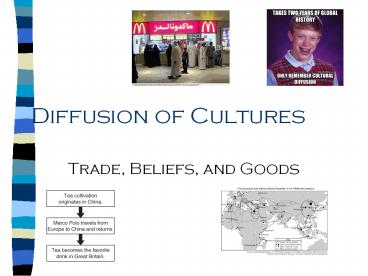Diffusion of Cultures PowerPoint PPT Presentation
Title: Diffusion of Cultures
1
Diffusion of Cultures
- Trade, Beliefs, and Goods
2
Diffusion of Cultures
- spread of ideas from central points
- adaptation of ideas to local needs
- creative additions
- Innovation, Diffusion, Acculturation
3
Major Trades Routes
- Where were the major trades routes in the Eastern
Hemisphere from 1000 to 1500AD? - Six Major Routes on or crossing three continents.
- Africa
- Asia
- Europe
- Trade routes connected most major civilizations.
4
Major Trades Routes
- All of these routes would connect with others at
certain points. - This meant the world was connected by trade, even
if most people never knew it. - These trade routes are one of the biggest reasons
cultural diffusion took place. - These routes helped ideas, technologies, etc
spread across the entire world.
5
Silk Road
- Runs across Asia
- to the Mediterranean.
6
(No Transcript)
7
Indian Ocean
- Routes from India to the Arabian Peninsula and
Africa
8
(No Transcript)
9
Sahara Desert
- Trans-Saharan Routes spread goods such as Gold
and Salt across the great desert.
10
(No Transcript)
11
The Black Sea
- Northern Europeans traveled by land and river to
the black Sea to trade with places like
Constantinople and beyond.
12
(No Transcript)
13
Western Europe
- Western Europeans depended on major rivers and
seas/the ocean to trade their goods.
14
(No Transcript)
15
Southeast Asia
- People crossed the China Sea and hopped from
Island to island in Southeast Asia to trade their
goods.
16
(No Transcript)
17
(No Transcript)
18
(No Transcript)
19
- Cultural diffusion
Religions ideas Trade innovations Agents of movement
Christianity Islam Buddhism Classical philosophy Mathematics Medicine Literature Religious architecture Agricultural methods urbanization Tribute Banking Paper currency Guilds Letters of credit Maritime technology Nomads Merchants Missionaries barbarians Empires
20
Silk Route Indian Ocean Black Sea Mediterranean Trans-Saharan
Camel caravan Spread of Islam and Buddhism Abbasid, Byzantine and Tang/Song tribute Mongols Delhi Sultanate Silk, perfumes, dyes, porcelain, lacquer ware Mongol open it up from one side to next Ibn Battuta and Marco Polo Banking, letters of credit paper money Paper making spread Silk production spread Indian cotton Merchants, missionaries Black death Samarkand, Constantinople, Chang An, Baghdad, Mongol Ilk Khanate Spice trade (nutmegs, cloves, cinnamon, ginger) Sugar introduced Goa, Calicut, Guang Zhou Spread of Buddhism and Islam Swahili city-States, Hindu Merchants Dhows, Lateen sails, junk ships African Gold Indian cotton Commercial elements of Dar Al Islam (guilds, banking, letters of credit) Europe omitted Constantinople, Novgorod, Kiev, Rus Byzantine Empire Eastern Orthodox Christianity Cyrillic alphabet, Onion domed cathedrals Mongol Golden Horde Crusades, Caliphate of Cordova, Venice. Constantinople, Byzantine Islam, Persia Italian city-states Black Death European commercial revolution Guilds, banking, joint stock companies Bourgeoisie Roman Catholicism High Middle Ages Animism Gold-Salt Islam Mali Timbuktu, Jene-Jene Islamic Scholarships Connection to Arab north then to Europe (2/3 of European Gold came from W Africa) Ghana, Mali, Songhai Dumb Barter Tribute Connection to East Africa Camel caravanserai Slavery University of Timbuktu
21
- From 600-1450 interregional trade in both the
Indian Ocean and Trans Sahara were dominated by
Muslim merchants interconnected through
regulations of the Sharia and fostered by guilds,
banking systems and Islamic Scholarships, both
utilized Arabic as the lingua franca (language of
trade) to foster trading relationships, however,
the influence of the Sudanic Kingdoms of Ghana,
Mali and Songhai would be felt only as far as the
Mediterrean trading Gold for Salt whilst the
Swahili city-states exports and imports of
sugar, spices and ivory could be felt as far away
as the Indian sub-continent, South China and the
Malay peninsula - Or
- The Silk Route and Western Europe interregional
trading networks 600-1450 were both predominantly
overland routes connecting civilizations and
empires through the spreading of goods like
textiles and foodstuffs, both would utilize
merchants whose advancements in financial
institutions (guilds, banking, letters of credit)
would facilitate more intensive trade, however,
the Silk route had been in existence for many
hundreds of years interconnection great trading
empires like the Abbasid and Tang/Song Dynasties
while Western European cities and guilds
(Hanseatic League, Italian city-states) entered
the picture later after the Middle Ages and did
not flourish economically for many hundreds of
years later.
22
Diffusion of Cultures
- Trade, Beliefs, and Goods

